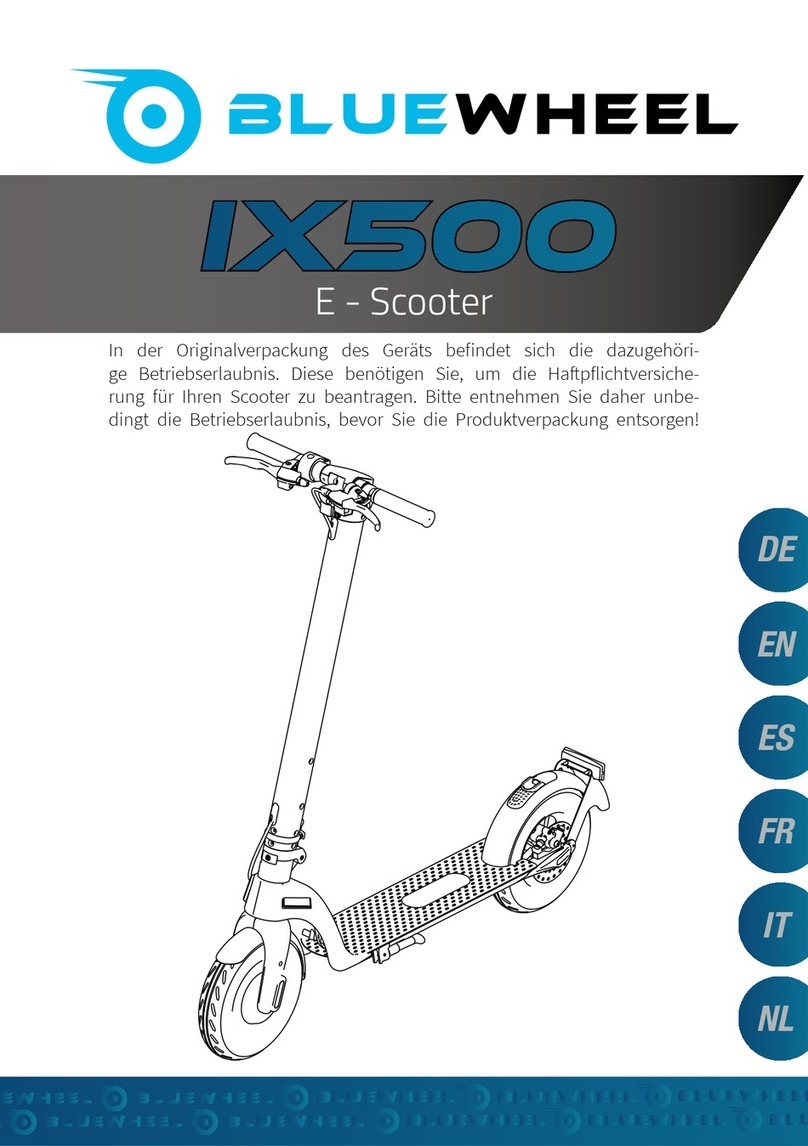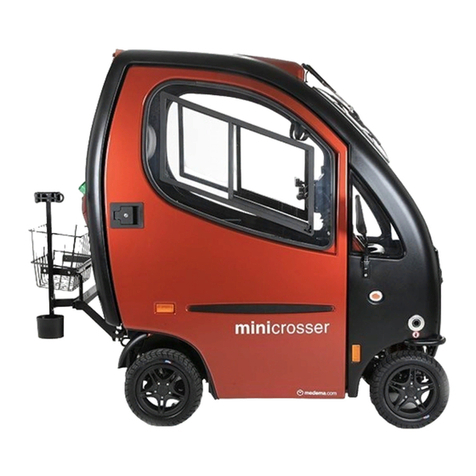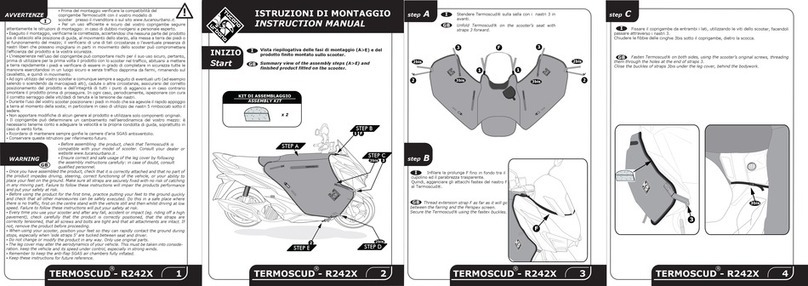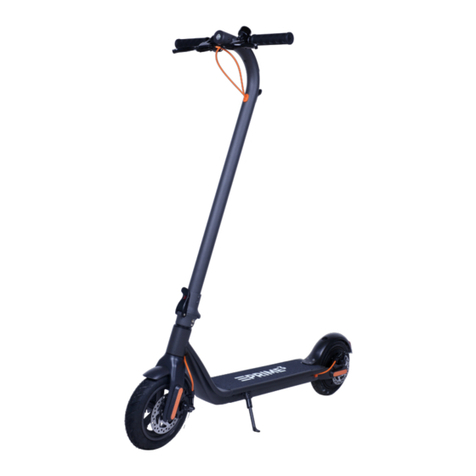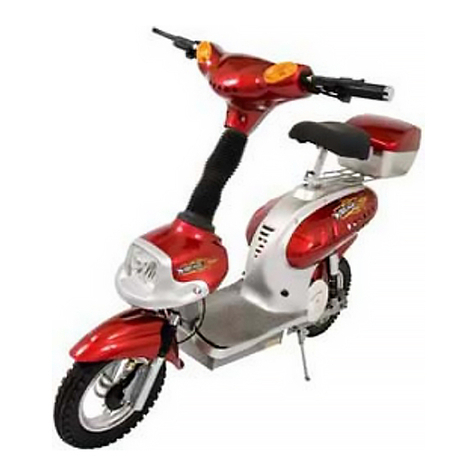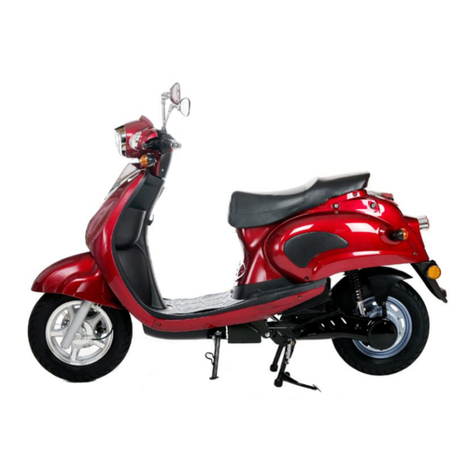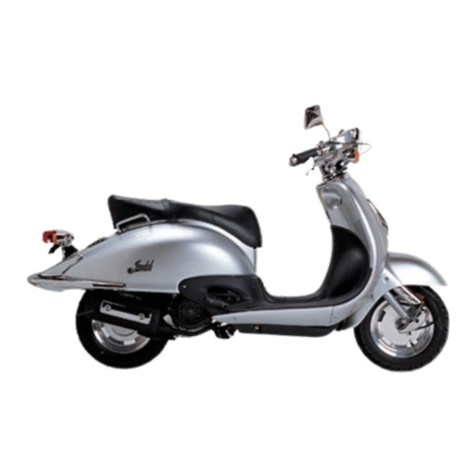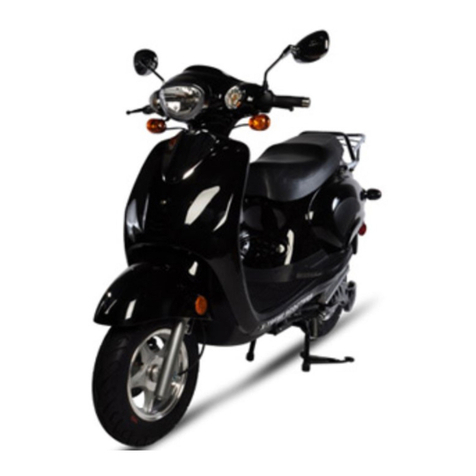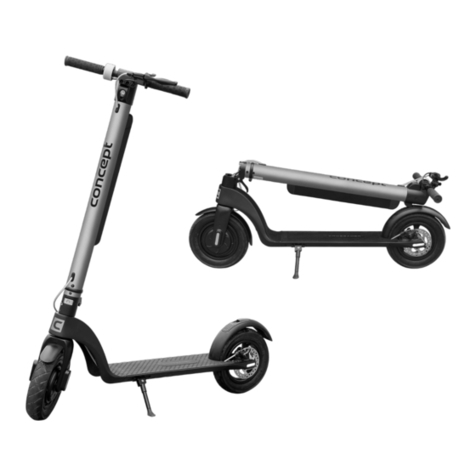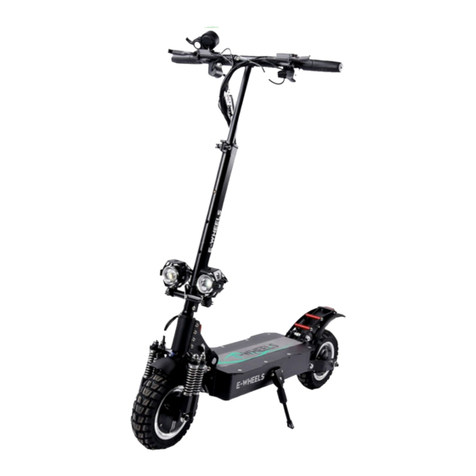HARTJE ESILENTIO User manual

Sales:
Hermann Hartje KG
Tel. +49 (0) 4251 - 811-500
www.hartje.de
USER MANUAL
AS ORIGINAL USER MANUAL
DIN EN 15194 / DIN EN 82079-1
E-BIKE (PEDELEC/EPAC)
93316_01_E_Silentio_20160302_a_enGB


3
» E-bike components
E-bike components
Control unit
Rechargeable battery
Charger
Drive

4
» Table of contents
E-bike components 3
In an emergency 6
Safety 7
General notes and information 7
Be absolutely sure to read the warning notes 7
Labelling of warning notes 7
Safety notes 8
Use 8
Rechargeable battery 9
Charger 10
Residual risks 11
Fundamental information 12
Symbols and terms 12
Symbols on the products 12
Symbols in this manual 13
Terms 13
Written labels 14
Units 14
Notes 15
E-bike 15
Differences between a bicycle and an e-bike 15
Functionality 15
Range 15
Cycling with an empty rechargeable battery 16
Drive overheat protection 16
Rechargeable battery 17
Charging times 17
Storing the rechargeable battery 17
Transporting or shipping the rechargeable battery 18
Protective equipment for charging 18
Charger 19
LED signals on the charger 19
Use 20
Road traffic 20
Areas of application of the rechargeable battery
and charger 20
Insurance 20
Lighting 20
Admissible total weight 20
Exclusion of wearable parts 20
Disclaimer 20
Transport 21
Disposal 22
Table of contents

5
Before each ride 23
Before your first ride 23
Your first ride 23
Testing instruction 23
Start-up 24
Preparations 24
Rechargeable battery 24
Charger 24
Operation 25
Rechargeable battery 25
Removing the rechargeable battery 25
Inserting the rechargeable battery 25
Charging indicator 26
Checking the charge level of the rechargeable battery 26
Charging the rechargeable battery 27
E-bike 29
Activating the e-bike 29
Deactivating the e-bike 30
Rechargeable battery indicator on the control unit 30
Setting the level of assistance 30
Lighting 31
Walk assistance 31
Care 32
Notes on the key 32
Troubleshooting 33
Technical data 35
Declaration of conformity 36
Credits 37
» Table of contents
Table of contents

6
You can find notes on handling the rechargeable battery in
this user manual. Despite compliance with all safety measures,
the rechargeable battery poses a risk, e.g. if it catches fire
(see chapter “Residual risks”).
• In an emergency, respond to ensure that you do not at any
time endanger yourself or other persons.
• In an emergency, follow the instructions on this page.
• Immediately read these instructions so that you can
concentrate and respond in a calculated manner in the event
of an emergency.
General protective measures
If you identify defects or damages to the rechargeable battery:
1. Do not use the rechargeable battery.
2. Wear protective gloves when you touch the rechargeable
battery.
3. Do not inhale any gases or vapours that are emitted.
4. Avoid contact between your skin and any liquid that is
leaked.
In the event of excessive heat
If you notice that excessive heat is being generated by the
rechargeable battery:
1. Have a specialist bicycle dealer check the rechargeable
battery immediately.
2. For short-term temporary storage, select an outdoor loca-
tion and, if possible, place the rechargeable battery in
a fire-proof container or on the soil.
3. If you store the rechargeable battery outdoors, clearly
secure the area with ample space around the storage
location.
In the event of deformation, odour, liquid
If you identify any deformation, odour or liquid leaked on the
rechargeable battery:
1. If possible, do the following if there is no danger: Place
the rechargeable battery in a fire and acid-proof container,
e.g. ade of rock or clay.
2. If you are able to transport the rechargeable battery with-
out any danger: Have your specialist bicycle dealer dis-
pose of the rechargeable battery immediately.
3. Select a fire-proof location outdoors for short-term tempo-
rary storage, e.g. on the soil.
4. If you store the rechargeable battery outdoors, clearly
secure the area with ample space around the storage
location.
If the rechargeable battery catches fire
1. Call the fire brigade immediately.
2. If possible, do the following if there is no danger: Use
plenty of water and sand to cool the fire.
In an emergency
» In an emergency

7
Be absolutely sure to read the warning
notes
Read all warnings and notes in this user manual with
care before you operate the e-bike for the first time.
This user manual is a supplementary manual and
integral part of the e-bike user manual. Keep all user
manuals so that they are handy and available at all times.
Include the user manual when passing the e-bike on to third
parties.
Labelling of warning notes
The sense of the warning notes is to draw your attention to
potential hazards. Your complete attention is required for the
warning notes; the statements must be understood completely.
Failure to follow a warning note may result in injury to yourself
or other persons. The warning notes alone cannot prevent
dangers. Follow all warning notes to avoid a risk when using
the e-bike.
There are safety notes in the following categories:
WARNING
The signal word “Warning” designates a hazard with
moderate degree of risk which may lead to death or
severe injury if not avoided.
CAUTION
The signal word “Caution” designates a hazard with low
degree of risk, which may lead to minor or moderate
injury if not avoided.
NOTICE
The signal word “Notice” warns against potential dam-
ages to property.
Safety »General notes and information
» Safety » General notes and information » Be absolutely sure to read the warning notes / Labelling of warning notes

8
WARNING
Risks for children and persons with impaired phys-
ical, sensory or mental capacities or lack of experi-
ence and knowledge, e.g. children or persons with
impaired mental and physical capacities.
The e-bike, rechargeable battery and the charger may
only be used by persons, who are able to act without
restriction with respect to their mental and physical
abilities. There is a high risk of injury for persons with
restricted mental and physical capacities.
• Only allow the e-bike, rechargeable battery and the
charger to be used by persons briefed on safe and
proper use and who understand the risks arising in
connection with it.
• Do not let children, young persons and persons with-
out a vehicle operator’s license to play with the e-bike.
WARNING
Risk of accident and injury!
Improperly performed repairs may cause accidents.
• Do not repair the e-bike yourself.
• Have repairs performed by your specialist bicycle dealer.
NOTICE
Risk of damage!
High or low temperatures could restrict the functioning
of the e-bike or damage it.
• Observe the temperature limits (see chapter “Technical
data”).
• Do not park the e-bike near heat sources.
Safety notes »Use
» Safety notes » Use

9
Safety notes »Rechargeable battery
WARNING
Risk of fire and explosion!
Internal damages to the rechargeable battery may cause
the rechargeable battery to overheat, emit gases or
leak liquids even a significant amount of time after the
damage occurred.
• Have your specialist bicycle dealer inspect the
rechargeable battery after falls or severe impacts.
• Do not open, dismantle, drill through or deform the
rechargeable battery.
WARNING
Risk of fire and explosion!
Rechargeable batteries that have caught fire are very dif-
ficult to extinguish; the cells affected must burn down in
a controlled manner. Responding properly may prevent
severe damages.
• Read the chapter “In an emergency” so that you are
properly prepared.
CAUTION
Risk of injury!
Lithium could be leaked if the rechargeable battery is
damaged. Lithium causes severe burns to the skin.
• Do not touch the damaged rechargeable batteries with
bare hands.
NOTICE
Risk of damage!
Improperly charging the rechargeable battery can dam-
age the rechargeable battery and the drive.
• Do not charge the rechargeable battery if you suspect
that it is damaged.
• Before charging the rechargeable battery for the first
time, be absolutely sure to read the chapter “Charging
the rechargeable battery”.
• Only use the original charger to charge the recharge-
able battery and only under supervision.
• While charging the rechargeable battery, always
place it on non-flammable materials (e.g. stone, glass,
ceramics).
» Safety notes » Rechargeable battery

10
Safety notes »Rechargeable battery/Charger
• If you are not absolutely sure how to handle lithium
ion rechargeable batteries, have a qualified specialist
explain how to do so.
NOTICE
Risk of damage!
Incorrect use of the rechargeable battery could cause
damage to the rechargeable battery, the drive or sur-
rounding objects, e.g. due to overheating.
• Only use the rechargeable battery included in the
product contents for the original drive.
• Only use original rechargeable batteries approved for
use with the original drive.
• Keep the rechargeable battery away from fire and other
heat sources; protect it against exposure to intense
sunlight.
• Protect the rechargeable battery against moisture.
Never clean or spray the rechargeable battery with
liquids.
• Do not use the rechargeable battery if you notice any
unusual warmth, odour or discolouration and/or if the
rechargeable battery exhibits obvious damages.
• Read the chapter “In an emergency”.
Charger
WARNING
Risk to life!
Incorrect handling of electrical current and correspond-
ing components poses a risk to life due to electric shock.
• Check the charger, mains cord and mains plug for
damage before each use.
• If you identify or suspect damages, do not use the
charger.
• Only use the charger indoors.
• Only connect the charger to a properly installed volt-
age supply “220 to 240 V ~ (50 Hz)”.
• Set up the charger so that it is not able to become
moist or wet, e.g. due to splashing water.
• Never clean or spray the charger with liquids.
Continued on the following page.
» Safety notes » Rechargeable battery / Charger

11
WARNING
Continuation
• While charging, always place the charger on non-flam-
mable materials (e.g. stone, ceramics).
• Do not open, dismantle, drill through or deform the
charger.
• Only have the charger repaired by qualified profession-
als with original spare parts.
• Only use the charger to charge the original recharge-
able battery or equivalent replacement rechargeable
batteries.
• Always pull the mains plug out of the socket after use.
• Read the additional safety notes on the housing of the
charger.
• If applicable, label the charger to prevent confusion
with chargers from other manufacturers.
Residual risks
Using the e-bike is associated with the following unforeseeable
residual risks despite compliance with all safety notes:
Risk of injury
-Gases, vapours and liquids could leak out of the recharge-
able battery due to internal, invisible damages and in the
event of fire. Injuries to external and internal organs are pos-
sible, e.g. in the event of contact with skin or inhalation of
the gases (see chapter “In an emergency”).
Fire hazard
-Internal, invisible damages can cause the rechargeable bat-
tery to catch fire and ignite objects in the surrounding area
(see chapter “In an emergency”).
Risk of damage
-If the rechargeable battery catches fire, hydrofluoric acid
leaks out with the smoke gas. Hydrofluoric acid is very
corrosive and causes permanent damage to surfaces
(see chapter “In an emergency”).
Safety notes »Charger|Residual risks
» Safety notes » Charger |Residual risks

12
Symbols on the products
The following symbols are located on the packaging, the
rechargeable battery or the charger.
Label for electrical devices that you must not dis-
pose of with household or other garbage. You are
obligated by law to dispose of correspondingly
labelled products at suitable recycling points for
environmentally-friendly recycling.
Label for rechargeable batteries and batteries that
you must not dispose of with household or other
garbage. You are obligated by law to dispose of
correspondingly labelled products at suitable recy-
cling points for environmentally-friendly recycling.
Label for waste materials intended for recycling.
Sort the packaging before you dispose of it. Dis-
pose of cardboard and carton as waste paper and
foils via the recyclable material collection service.
Symbol confirming conformity with guidelines for
products corresponding to the requirements of the
European General Product Safety Directive.
Labelling for products that may only be used
indoors.
The 230 V ~/50 Hz mains connection corresponds
to protection class II.
Fundamental information »Symbols and terms
» Fundamental information » Symbols and terms » Symbols on the products

13
Symbols in this manual
1. Steps to be performed in a particular order
begin with a number.
•Steps to be performed in no particular order
begin with a dot.
–Lists begin with a so-called dash.
»Separates a chapter if the chapter is subordi-
nate to the previous one.
/Separates a chapter if the chapter is not sub-
ordinate to the previous one.
|Separates a chapter if the chapter is superor-
dinated to the previous one.
NOTICE: Supplementary notes regarding steps to be
performed or use.
Terms
Terms with “nominal”: Nominal output, nominal capacitance
etc. are values stipulated according to the design. The actual
values may vary from the nominal values depending on oper-
ating conditions.
E-bike (Pedelec/EPAC): An e-bike is a bike powered by an
electrical auxiliary motor. E-bikes of this kind are also referred
to as pedelecs (pedal electric cycle) or EPAC (electric power
assisted cycles). The term “e-bike” will be used hereinafter.
Capacitance: The amount of electrical charge in the unit “Ah”
if the rechargeable battery has been completely charged
(see chapter “Units”).
Charging cycle: Refers to fully charging a completely depleted
rechargeable battery.
Memory effect: Refers to the loss in the capacitance of
rechargeable batteries if they are not completely charged
(does not apply to lithium ion rechargeable batteries).
Pedal drive: Assembly consisting of pedal, crank arm and
chainwheel.
Temperature limits: Minimum and maximum temperature at
which the corresponding component may be used. At the
same time, both the temperature limits for the component as
well as for the ambient temperature may be specified.
Pedalling frequency: Number of revolutions of the pedal drive
in one second expressed in the unit “1/s”.
Fundamental information »Symbols and terms
» Fundamental information » Symbols and terms » Symbols in this manual / Terms

14
Written labels
-Image captions and references in the text are rendered in
italics.
-Emphasis of passages in the text are underlined.
Units
Unit Meaning Unit for
1/s per second Revolutions
AAmperes Electric current (=W/V)
Ah Ampere hour Electric charge (=Wh/V)
gGram Weight (=kg/1000)
Hz Hertz Frequency (Hz=oscillation/s)
kg Kilogramme Weight (=g×1000)
Nm Newton meter Torque
VVolt Electric voltage (=W/A)
WWatt Electric power (A/V)
Wh Watt hour Electric capacitance (=V×Ah)
Fundamental information »Symbols and terms
» Fundamental information » Symbols and terms » Written labels / Units

15
Differences between a bicycle and an e-bike
The additional components of the electric drive constitute the
major differences between a conventional bike and an e-bike.
-The e-bike’s weight is considerably greater and its weight
is distributed differently than with conventional bikes. This
results in different handling.
-The drive has a significant effect on braking characteristics.
-E-bikes require greater braking forces. This may result in
greater wear than with conventional bicycles.
-The electrical assistance will increase your average speed.
• You should therefore cycle attentively. Keep in mind that
other road users must get used to the increased speed
of the e-bike.
-The bike’s handling and braking as well as handling of the
rechargeable battery and charger require an appropriate
level of knowledge.
• Familiarise yourself with the characteristics of your
e-bike even if you already have some experience with
electric assisted bicycles (see chapter “Notes » Use
» Before your first ride”).
Functionality
The drive only provides assistance when you pedal. The inten-
sity of assistance is automatically adjusted depending on the
selected riding mode, the pressure applied when pedalling,
the load and the speed. The drive assists you up to a speed
of 25 km/h.
Range
The drive is an assistive motor. The range is affected by your
pedalling intensity.
• Set the assistance as low as possible.
The lower the pedalling frequency of the pedal drive the higher
the energy requirement for the drive.
• Use the gear shift as you would without assistance.
• For inclines, head wind or a heavy load, use the lower gears
of the gear shift.
The drive requires a large amount of energy when starting.
• Always start in a low gear and apply as much pressure to
the pedal as possible.
• Before travelling uphill, switch to a lower gear in time.
• Ride with foresight to avoid any unnecessary stops.
Notes »E-bike
» Notes » E-bike » Differences between a bicycle and e-bike / Functionality / Range

16
The energy consumption will increase with high loads.
• Do not transport any unnecessary loads.
Lack of care and maintenance may reduce the range.
• Handle the e-bike with care and observe all notes regarding
the rechargeable battery in this user manual.
• Check the tyre pressure regularly.
• Comply with the maintenance intervals.
Temperatures below +10 °C may negatively affect the perfor-
mance of the rechargeable battery during operation. When
you are not using your e-bike:
• At low outdoor temperatures, take the rechargeable bat-
tery out of the holder and store it (see chapter “Notes
» Rechargeable battery » Storing the rechargeable battery”).
• Only put it back in the holder directly before cycling.
Cycling with an empty rechargeable
battery
If the rechargeable battery is completely used up during the
ride, you can use your e-bike as you would a normal bike
(see chapter “Operation"» Rechargeable battery » Charging
indicator”).
Drive overheat protection
CAUTION
Risk of injury!
The drive and rechargeable battery can become very hot
if a fault is at hand. You could injure yourself in the event
of contact with your skin.
• Do not touch the drive and the rechargeable battery.
The drive is automatically protected against damage caused
by overheating. If the temperature of the drive is too high, the
drive will automatically switch off.
• To prevent the drive from overheating, set a low level of
assistance at high outdoor temperatures or roads or paths
with a substantial incline (see chapter “Operation » E-bike
» Setting the level of assistance”).
• If the drive is switched off when the rechargeable battery
is charged and at a speed of under 25 km/, do not use the
e-bike temporarily to allow the drive to cool off.
• If allowing the drive to cool off does not resolve the dis-
turbance, have your specialist bicycle dealer inspect the
e-bike.
Notes »E-bike
» Notes » E-bike » Range / Cycling with an empty rechargeable battery / Drive overheat protection

17
• Keep in mind that the output of the rechargeable battery
may begin to decline after 500 complete charging processes
(charging cycles).
• Keep in mind that you will get used to cycling with electrical
assistance after a while. This may result in a perceived drop
in the output of the rechargeable battery.
• If there is a loss of power or the operating time is significantly
reduced, contact your specialist bicycle dealer.
• Never perform any modifications on the rechargeable
battery.
NOTICE: You can find more information about the rechargea-
ble battery in the chapter “Operation » Rechargeable battery”.
Charging times
If the rechargeable battery is empty, a full charge cycle
requires 4 to 6 hours. The duration of the rechargeable battery
charge cycle depends on the following factors:
-Charge level of the rechargeable battery.
-Temperature of the rechargeable battery and surroundings.
Storing the rechargeable battery
If you do not use the rechargeable battery for a prolonged
period of time, please store it as follows:
• Charge the rechargeable battery to approx. 60 to 80 % of
the capacitance.
Your e-bike is equipped with a high-quality lithium-ion recharge-
able battery (Li-ion rechargeable battery). Li-ion rechargeable
batteries are safe if used properly. Li-ion rechargeable batteries
have a relatively high energy density. Therefore, this recharge-
able battery must be handled with great care. For your safety,
be absolutely sure to observe the following notes to ensure
reliable operation and a long life-cycle:
Partial charging does not damage the rechargeable battery as
it does not have a memory effect. Partial charging is evaluated
according to its capacitance (a charge of 50 % corresponds
to ½ charge cycle).
NOTICE
Risk of damage!
Self-discharge of the rechargeable battery for technical
reasons may cause irreparable damages.
• Immediately recharge the rechargeable battery if empty.
• Take note of the temperature limits of the rechargeable
battery (see chapter “Technical data”).
• Please note that outside temperatures under +10°C may
reduce the power of the rechargeable battery.
Notes »Rechargeable battery
» Notes » Rechargeable battery » Charging times / Storing the rechargeable battery

18
Transporting or shipping the rechargeable
battery
Lithium ion rechargeable batteries are subject to the require-
ments of dangerous goods legislation. The private user may
transport undamaged rechargeable batteries on the road with-
out any further requirements.
• Please note that the special requirements for packaging and
labelling e.g. during air transport or shipping orders apply
for commercial transport.
• Contact e.g. the forwarding company or your specialist bicy-
cle dealer directly for information regarding the transport of
the rechargeable battery and suitable transport packaging.
NOTICE: To transport the e-bike, read the chapter “Notes
» Use » Transport”.
Protective equipment for charging
The rechargeablebatteryis equippedwith atemperature monitor,
which only permits charging within a temperature range between
0 °C and +40 °C. If the rechargeable battery is outside of the
temperature limits, the charging process will automatically end.
• For storage, take the rechargeable battery out of the holder
and place it in a safe location.
• Store the rechargeable battery so that there is no risk of it
falling down and so that it is not accessible for children and
animals.
• If possible, store the rechargeable battery at room temper-
ature in a dry, well ventilated area.
• If you do not use the rechargeable battery for a prolonged
period of time, it is best to store the rechargeable battery
in a well ventilated location such as a basement at
approx. +10 to +15 °C.
• Protect the rechargeable battery against moisture and water.
• Make sure that the top and bottom temperature limit is
not exceeded or underrun during storage (see chapter
“Technical data”).
• For storage exceeding 3 months, please recharge the
rechargeable battery every quarter to half year depending
on storage conditions. Then charge the rechargeable bat-
tery again to approx. 60 to 80 % of the capacitance.
• After the charging process, always disconnect the charg-
er from the rechargeable battery and pull the mains plug
out of the socket.
Notes »Rechargeable battery
» Notes » Rechargeable battery » Transporting or shipping the rechargeable battery / Protective equipment for charging

19
Notes »Charger
CAUTION
Risk of injury!
Temperatures of over 40 °C can cause injury to the skin.
• If you would like to end the charging process prema-
turely, let the rechargeable battery cool off.
1. Pull the mains plug out of the socket.
2. Once the rechargeable battery has cooled off, pull the
charging plug out of the charging slot.
3. Have your specialist bicycle dealer inspect the rechargeable
battery.
The original charger operates with CC-CV technology. CC-CV
means that the remaining 5 % of the capacitance is attained
after approx. four hours in gentle CV mode. The LED on the
charger indicates the respective charge mode.
LED signals on the charger
• When charging the rechargeable battery, observe the LED
signals on the charger (see table 1 and figure H-1)
LED on the charger Charge status
Yellow – green Standby; no rechargeable battery
connected
LED on the charger Charge status
Red – continuous light Charging process 0 – 95 % (CC
charge)
Yellow – continuous
light
Charging process 95 – 100 % (CV
charge)
Green – continuous
light
Charging process complete
Table 1: LED signals on the charger.
LED
Figure H-1: The LED on the charger indicates the charge status.
» Notes » Charger » LED signals on the charger

20
Road traffic
The assistance provided by e-bikes is effective up to a speed
of 25 km/h. The technical configuration of your e-bike complies
with the European standard EN 15194 for electrically power
assisted bicycles and the bicycle standard DIN ENISO 4210-2.
• Get information regarding the respectively valid regulations
on road traffic for your country or the region, e.g. from bicy-
cle associations or the ministry of transport.
• Ensure that you regularly obtain information regarding
changes to the content of valid regulations.
Areas of application of the rechargeable
battery and charger
The drive unit, rechargeable battery and charger are configured
for use with one another and are approved only for use with
your e-bike.
Insurance
• Check whether the conditions of your insurance policies
(e.g. liability insurance, household contents insurance)
sufficiently cover damages.
• In case of doubt, contact your insurer office.
Lighting
Your e-bike is equipped with rechargeable battery-powered
lighting. The rechargeable battery must always be inserted
when using public roads so that the lighting is operational at
all times.
Admissible total weight
The total admissible weight of your e-bike is specified on the
CE sticker (see figure H-2). The sticker is located on the inside
of the chain stays.
gefertigt nach DIN 15194
Nenndauerleistung 250W bis 25km/h
zulässiges Gesamtgewicht 130 Kg
Hermann Hartje KG .Deichstraße 120-122
27318 Hoya/Weser .Germany .www.e-rad.de
BJ: 2016
Figure H-2: CE sticker specifying the total admissible weight.
Exclusion of wearable parts
In addition to the wearable parts listed in the user manual for
the bicycle, the rechargeable battery – with the exception of
production defects – is not covered by the warranty.
Disclaimer
The manufacturer cannot be held liable for damages or break-
downs resulting from direct or indirect use of the e-bike.
Notes »Use
» Notes » Use » Road traffic / Rechargeable battery and charger / Insurance / Lighting / Admissible total weight / ...
Table of contents
Other HARTJE Scooter manuals

